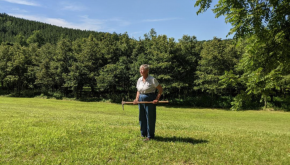
This is the second in a series of WOW Entomology publications. Each publication highlights a common insect impacting forests in a particular region of the United States, paired with an interview of a woman landowner who has had to address that insect in managing her forest.
Please check out the full publication!
Carolyn Brown and her husband live on 700 acres nestled at the base of the Blue Ridge Mountain escarpment in the Northwest corner of South Carolina. Most of their property contains natural woodlands with mixed hardwoods, and native pine with white oak in higher elevations. Carolyn spent much of her childhood on this land, eventually inheriting the property from her aunt and uncle, and has been residing permanently on the property since 1981.
Carolyn and her husband envisioned a farm with established trees for the next generation to enjoy. Over the past thirty years, they've worked towards achieving this goal with plantings of loblolly pine, black walnut, yellow poplar, cherrybark oak, and green ash. In the summer of 2020, Carolyn discovered that the majority of the green ash trees on their property had died from an infestation of emerald ash borer (EAB). With the help of their regional forester, Carolyn is developing a plan to treat or remove the infested trees without harming the local pollinator populations, establishing a nature preserve where the trees once stood.
Carolyn's forest stewardship approach
My favorite place on the farm is a section of river bottom that is accessible by a narrow road between the river and a sharp ridge descending to the river. Approaching the area, you walk by a small hay field that produces hay for mulching the garden. Walking further, you see a small pecan grove by the river, and then a large, fenced vegetable garden, beyond which is our sawmill and the beehives. The beehives are in an old schoolbus with slots on the sides with landing boards for the bees. The bus is bear protection...
As you stand there, your eye goes to our 40-acre yellow poplar plantation now ready for its first thinning. You see MCP loblolly pine not quite ready for its first thinning, and then a small grove of loblolly planted in 1991 standing majestically, ready for its next thinning. Moving on, you see some natural woodlands in “Spring Cove” next to a stand of old growth yellow poplar. Beyond is a small stream with a number of big, beautiful Green Ash. We discovered late last summer that they were mostly dead. The emerald ash borer had arrived.
Emerald ash borer impacts
The borer seems to prefer larger, older trees. Our fourteen-year-old planted ash trees have leafed out this year with only a few affected trees, although some seem to be struggling. We rejected the use of the suggested systemic chemicals since they kill pollinators indiscriminately. The alternative was to cut all of the trees down before May, when the borer exits the tree (although the borer might still mature in the down timber). The ash trees were not large enough for lumber, but we figured we could make use of the trees for firewood, as both houses on the farm are heated with wood. So we bought a small feller-buncher that fits on our skid-steer, which we found to be a great tool for our pre-commercial thinnings. We did not start cutting trees, however, because we learned of an alternative using a parasitoid wasp. This is where we are now.
Getting forest management assistance
The Regional Forester and the Forest Service entomologist came to the farm and confirmed our problem. This was the first documented occurrence of EAB in the state. When the forester and entomologist came to see the Ash trees, we took them first to the large native ash along one of the streams. Some of the trees were still struggling to stay alive. They pointed out the abundance of epicormic growth (often a stress response). The entomologist removed some of the bark, revealing the grid (gallery) work of the borer. We also felled a tree for him to check for borer at the top of the tree; it was there. One option was for us to cut down all the trees before May, when the insect emerges. However, when we received an email asking if we would like to have a release of a parasitoid wasp, we answered "Yes!"
Potential silver linings
The planted ash trees are in a section of bottomland that has wet areas and drier areas. If it is necessary to clear-cut the ash, we are considering establishing a 14-acre nature preserve with many different flora and fauna sites. Everyone in the family is interested in the nature preserve as a replacement for the Ash plantation; each person wants to take an area to try out their ideas. For now, we will watch the Ash plantation and hope that some individual trees might show some resistance.
EMERALD ASH BORER
We invite you to explore the linked entomology publication for information on EAB's impacts, life stages, geographic range, and signals by which to identify it on your property--as well as the forest management implications of its presence.
Please follow this link for the full interview with Carolyn and an EAB fact sheet!
Read #1 in this series about Alaska landowner Donna Massay's efforts to mitigate spruce bark beetle damage on her property.

